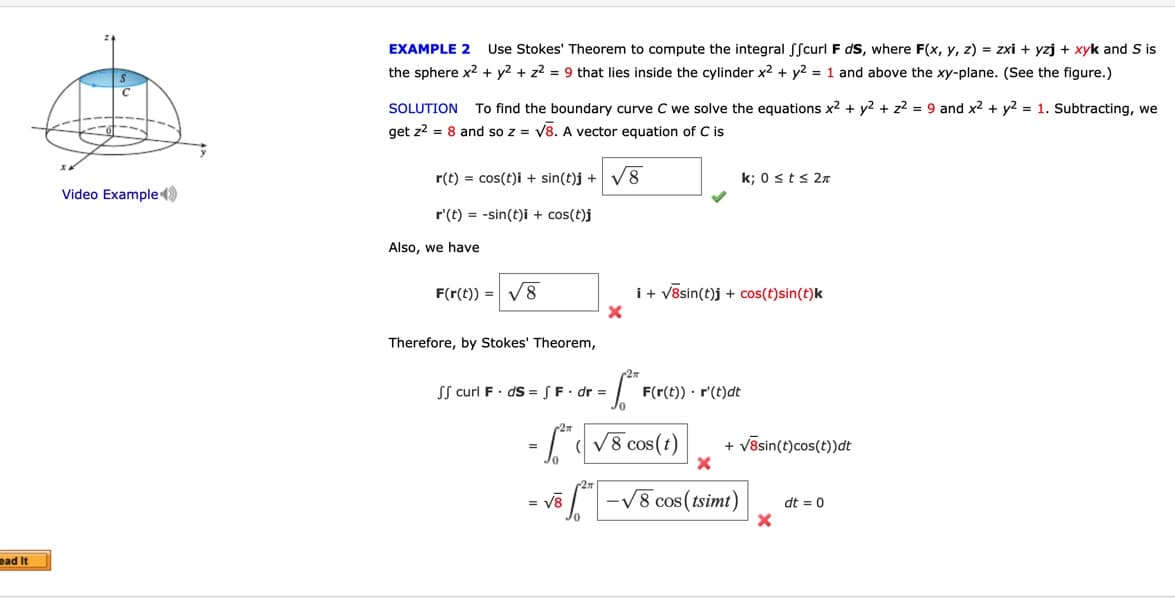EXAMPLE 2 Use Stokes' Theorem to compute the integral fſcurl F ds, where F(x, y, z) = zxi + yzj + xyk and S is the sphere x2 + y2 + z2 = 9 that lies inside the cylinder x2 + y? = 1 and above the xy-plane. (See the figure.) SOLUTION To find the boundary curve C we solve the equations x2 + y2 + z2 = 9 and x2 + y2 = 1. Subtracting, we get z? = 8 and so z = V8. A vector equation of C is r(t) = cos(t)i + sin(t)j + V8 k; 0sts 2n Video Example () r'(t) = -sin(t)i + cos(t)j Also, we have F(r(t)) = V8 i+ V8sin(t)j + cos(t)sin(t)k Therefore, by Stokes' Theorem, SS curl F. dS = SF. dr = F(r(t)) r'(t)dt V8 cos(t) + V8sin(t)cos(t))dt = V8 -V8 cos (tsimt) dt = 0
EXAMPLE 2 Use Stokes' Theorem to compute the integral fſcurl F ds, where F(x, y, z) = zxi + yzj + xyk and S is the sphere x2 + y2 + z2 = 9 that lies inside the cylinder x2 + y? = 1 and above the xy-plane. (See the figure.) SOLUTION To find the boundary curve C we solve the equations x2 + y2 + z2 = 9 and x2 + y2 = 1. Subtracting, we get z? = 8 and so z = V8. A vector equation of C is r(t) = cos(t)i + sin(t)j + V8 k; 0sts 2n Video Example () r'(t) = -sin(t)i + cos(t)j Also, we have F(r(t)) = V8 i+ V8sin(t)j + cos(t)sin(t)k Therefore, by Stokes' Theorem, SS curl F. dS = SF. dr = F(r(t)) r'(t)dt V8 cos(t) + V8sin(t)cos(t))dt = V8 -V8 cos (tsimt) dt = 0
Algebra & Trigonometry with Analytic Geometry
13th Edition
ISBN:9781133382119
Author:Swokowski
Publisher:Swokowski
Chapter9: Systems Of Equations And Inequalities
Section: Chapter Questions
Problem 12T
Related questions
Question
can you do please
16.8b6

Transcribed Image Text:EXAMPLE 2
Use Stokes' Theorem to compute the integral Sſcurl F ds, where F(x, y, z) = zxi + yzj + xyk and S is
the sphere x2 + y2 + z2 = 9 that lies inside the cylinder x2 + y2 = 1 and above the xy-plane. (See the figure.)
SOLUTION
To find the boundary curve C we solve the equations x2 + y2 + z? = 9 and x2 + y2 = 1. Subtracting, we
get z? = 8 and so z = V8. A vector equation of C is
r(t) = cos(t)i + sin(t)j + V8
k; 0sts 2x
Video Example )
r'(t) = -sin(t)i + cos(t)j
Also, we have
F(r(t)) = V8
i+ v8sin(t)j + cos(t)sin(t)k
Therefore, by Stokes' Theorem,
ff curl F· dS = [F. dr =
F(r(t)) · r'(t)dt
- LV8 cos( )
+ v8sin(t)cos(t))dt
-V8 cos (tsimt)
= V8
dt = 0
pad It
Expert Solution
This question has been solved!
Explore an expertly crafted, step-by-step solution for a thorough understanding of key concepts.
This is a popular solution!
Trending now
This is a popular solution!
Step by step
Solved in 2 steps with 2 images

Knowledge Booster
Learn more about
Need a deep-dive on the concept behind this application? Look no further. Learn more about this topic, calculus and related others by exploring similar questions and additional content below.Recommended textbooks for you

Algebra & Trigonometry with Analytic Geometry
Algebra
ISBN:
9781133382119
Author:
Swokowski
Publisher:
Cengage

Algebra & Trigonometry with Analytic Geometry
Algebra
ISBN:
9781133382119
Author:
Swokowski
Publisher:
Cengage